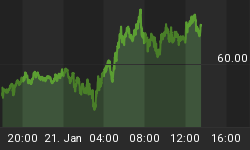Below is an extract from a commentary originally posted at www.speculative-investor.com on 8th March 2007.
With the stock market having most likely commenced an intermediate-term correction it's a good time for us to go over some old ground; specifically, we are going to re-visit the relationship between the silver/gold ratio and the broad stock market that we've discussed a number of times over the past several years.
One of the most reliable relationships in the financial world since the early 1970s can be expressed as follows: silver outperforms gold when confidence in financial assets is rising and under-performs gold when confidence in financial assets is falling. This relationship can sometimes be obscured in real time by the silver/gold ratio's volatility, but is usually apparent in longer-term chart comparisons of the silver/gold ratio and the S&P500 Index. For example, the following chart shows that the silver/gold ratio and the S&P500 Index have moved in lock-step over the past seven years -- falling together from the second half of 2000 through to the first half of 2003 and rising together thereafter.
The correlation between the silver/gold ratio and the S&P500 hasn't always been as 'tight' as it has been during the most recent cycle; however, over the past 35 years silver/gold's longer-term trends can usually be linked to confidence in financial assets as mentioned above and as more fully described in our 31st May 2006 commentary.

Silver has clearly outperformed gold since mid-2003, which is exactly what it should have done given that confidence has been in a powerful upward trend since that time. This upward trend in confidence is evidenced by the S&P500's cyclical bull market, but is perhaps even more readily apparent in the dramatic narrowing of spreads between the yields on high-risk and low-risk debt securities.
Further to the above, we don't think it makes sense to analyse silver's prospects relative to those of gold without taking into account the outlook for equities and economic growth. Along these lines, those who are very bullish on silver relative to gold and simultaneously very bearish on the US stock market really should explain why a relationship that has worked reasonably well for 35 years and appears to have become stronger over recent years is suddenly going to stop working.
From our perspective, there are two important considerations:
First, we are sympathetic to the argument eloquently put forward by Franklin Sanders (The Moneychanger newsletter) that silver's extensive industrial usage and much smaller market size will cause incremental increases in investment demand for precious metals to have a greater positive effect on the silver price than on the gold price. However, we can't ignore the empirical evidence indicating that silver will under-perform gold once the cyclical equity bull market of the past few years ends and the next cyclical bear market begins. Given that the stock market's current bull run is already an outlier in terms of duration, we are wary about making an investment choice whose success could depend upon a lengthy extension of the bull's life.
Second, gold's proven ability to out-perform silver when confidence is in a downward trend has a logical basis in that gold's price is almost totally driven by changes in investment demand whereas industrial demand is a very important factor in the silver market. In other words, when confidence is falling there will generally be a flight toward money that should logically benefit the more monetary metal relative to the more industrial one.
These considerations lead us to conclude that one of the following must happen for silver to out-perform gold over the next few years:
1. A quick end to the stock market downturn that commenced in February followed by resumptions of the global upward trends in equities and growth (and the associated upward trend in confidence) that began in 2003
2. A gain in the investment demand for silver during major (1-2 year) declines in equities and financial/economic confidence of sufficient size to not only offset a drop-off in silver's industrial usage, but to also offset the effect, on the gold price, of the increased investment demand for gold that would likely occur under such circumstances.
Cutting to the chase, we suspect that silver WILL out-perform gold over the remainder of the long-term precious metals bull market, mainly because the US is not the global growth engine it once was and the long-term outlook for non-US economic growth remains bullish. However, we continue to view it as much riskier than gold because there are more things that could go wrong with a silver investment than with a gold investment. We therefore continue to believe that gold-related exposure should have a significantly greater weighting than silver-related exposure in an investment portfolio.















